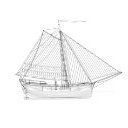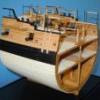-
Posts
13,154 -
Joined
-
Last visited
Reputation Activity
-
 druxey reacted to Chuck in Syren Ship Model Company News, Updates and Info.....(part 2)
druxey reacted to Chuck in Syren Ship Model Company News, Updates and Info.....(part 2)
working on larger blocks now...
11/32" singles and doubles now available and I am cooking the 5/16 as I write this. Below is an 11/32" (9mm) single block with 3mm thimble and a hook fashioned from 22 gauge black wire. The sheave was also darkened with a #2 pencil as you can easily do that with these bigger blocks. Once the 5/16" are done I will make 9/32" blocks. I think 9mm or 11/32" blocks are the biggest I will make. I cant see much need for larger blocks? But I may be wrong.
-
 druxey reacted to Chuck in Syren Ship Model Company News, Updates and Info.....(part 2)
druxey reacted to Chuck in Syren Ship Model Company News, Updates and Info.....(part 2)
Thank You for saying...
French Style Lantern version one is now available in 1/4" scale with glass insert. Assembled just as the last one I showed. These are after Boudriot.
-
 druxey reacted to Chuck in shiny rope
druxey reacted to Chuck in shiny rope
Actually the inevitable very fine dust that will settle on your model and rigging should make that barely noticeable. It wont remain shiny at all for long. 😉
Chuck
-
 druxey reacted to BenD in shiny rope
druxey reacted to BenD in shiny rope
The polyester ropes I make at Ropes of Scale are a bit shiny. It's only really noticeable on the black and dark brown ropes. I've noticed that it helps make the details pop even in low lighting, so I'd personally leave them as is.
Brushing the ropes down with matt varnish after rigging is an option. In the picture, you see unvarnished ropes on the right and varnished ones on the left.
-
 druxey got a reaction from Knocklouder in Mary Rose by Baker - scale 1/50 - "Your Noblest Shippe"
druxey got a reaction from Knocklouder in Mary Rose by Baker - scale 1/50 - "Your Noblest Shippe"
I smile at the actual random pattern of deck planking - so very different than seen on most models!
-
 druxey reacted to Baker in Mary Rose by Baker - scale 1/50 - "Your Noblest Shippe"
druxey reacted to Baker in Mary Rose by Baker - scale 1/50 - "Your Noblest Shippe"
Construction of the knight for the main yard.
It appears that i placed the main mast too far back.
Corrected position.
Knigt and the base plates for the upper deck placed. With the layout roughly sketched.
And start planking.
First the piece that is still left, then the remaining part (a puzzle...)
-
 druxey reacted to Baker in Mary Rose by Baker - scale 1/50 - "Your Noblest Shippe"
druxey reacted to Baker in Mary Rose by Baker - scale 1/50 - "Your Noblest Shippe"
Thanks Steven,
This capstan also served to raise the anchors and is therefore placed on the upper deck.
On the upper deck of the rear castle there is a winch for operating the mizzen sail.
But, I completely forgot about the knight For the main sail.
Thanks for bringing this up.
-
 druxey reacted to Louie da fly in Mary Rose by Baker - scale 1/50 - "Your Noblest Shippe"
druxey reacted to Louie da fly in Mary Rose by Baker - scale 1/50 - "Your Noblest Shippe"
The Lomellina (Genoese, sank 1516) had a capstan a little aft of the mainmast, with a knight between the two.
As the May Rose's mast appears to have been directly forward of the aftercastle, it would perhaps be a little differently arranged. But Generally I'd expect it to be similar. On my Great Harry, I put the knight and capstan on the upper deck of the aftercastle - see post #308 at
but that's not to say my interpretation is correct. By the way, note that unlike later capstans, the holes for the bars pass right through the capstan and are at two different levels. So there are only two bars, each of which extends out from both sides of the capstan, so there are only four positions for the crew to push at the capstan.
I hope that helps.
Steven
-
 druxey got a reaction from catopower in Endeavour 1934 by Herbert Heger - 1:35
druxey got a reaction from catopower in Endeavour 1934 by Herbert Heger - 1:35
Könnten Sie bitte entweder schreiben oder einen Übersetzungsdienst ins Englische nutzen? Danke!
Ihr Projekt sieht interessant aus.
(Can you please either write or use a translation service into English? Thank you!
Your project looks interesting.)
-
 druxey reacted to Herbert Heger in Endeavour 1934 by Herbert Heger - 1:35
druxey reacted to Herbert Heger in Endeavour 1934 by Herbert Heger - 1:35
Hallo , heute moechte ich den Baubericht meiner Endeouver beginnen . Nach einigen Standmodellen ( Adler von Luebeck , Fregatte Berlin , San Felipe , Soleil Royal ) wird dies meine erste Yacht sein , Es wuerde mich freuen wenn recht viele meinen Bericht kritisch begleiten . Viel Spass
-

-
 druxey reacted to The Bitter End in The Margheretta may have been found
druxey reacted to The Bitter End in The Margheretta may have been found
Here you go
For more than two centuries, stories have circulated along the Washington County coast: that the British burned a captured Revolutionary War schooner in Jonesport’s Sawyer Cove. Some versions were recorded in 19th-century newspapers and George Drisko’s 1904 “Narrative of the Town of Machias.” Others were handed down through families like the Sawyers.
In the 1960s, Valdine Atwood and her mother followed those stories to the shoreline. “Dorley Sawyer’s family lived nearby,” said Atwood, now a Machias historian. “And the story passed down was that they saw the Margaretta beached, saw the crew run into the woods, and saw the British come and set it afire.”
No wreck was visible on the day of their visit to the shore, but Atwood reached blindly into the mud and pulled up a piece of timber.
On their way out, they passed a white cross on the rocks.
“They used to do that to mark a shipwreck,” she said.
Atwood said she always believed the stories. Now, a multi-year archaeological study strongly supports her instincts and centuries of oral tradition — the wreck of the Margaretta likely lies in Sawyer Cove.
The area around Sawyer Cove is now private property, with no public access, but a neighboring landowner permitted the research team to work on-site.
“The wreck in Jonesport, we think, is Margaretta,” said archaeologist Arthur Spiess, co-author of a report about the shipwreck that is soon to be released by the Maine Historic Preservation Commission and the Natural Resources Conservation Service. “There’s no evidence against it, and some strong evidence for it.”
Spiess and fellow archaeologist Nathaniel King were alerted to the shipwreck in 2021, when Maine Game Warden Joe McBrine — also a local historian — heard reports of “a ship coming up out of the mud.”
“At low tide, you could see it,” recalls McBrine. “We measured it, and it was within a couple of feet of what the Margaretta would have been. I thought, ‘Man, this could really be it.’”
McBrine already knew the story well. As a member of the Machias Historical Society and a local reenactment group, he’s spent years educating the public about Washington County’s Revolutionary War-era clashes — including what some view as the first naval battle of the American Revolution, the Battle of the Margaretta.
That battle began just weeks after Lexington and Concord. On June 2, 1775, three ships sailed into Machias Bay — among them the British schooner HMS Margaretta. Their mission: to trade for lumber, forcibly if necessary, to supply British troops occupying Boston.
The residents of Machias had other ideas. They planned to capture the British officers during Sunday services, but when the British escaped to their vessel and sailed for Machias Bay, the Americans gave chase. They met in battle exactly 250 years ago, from June 11 to 12 of 1775.
The clash ended with the deaths of three Americans — John McNeil, Robert Avery, and James Coolbroth — and the injury of several others, as well as the mortal wounding of British commander James Moore and the capture of the Margaretta. The Americans soon hid the 50-ton schooner in what is now Marshfield’s Middle River.
In 1776, when Machias men judged it safe to move the vessel, they likely reballasted her in Machias — using local ballast stones that now provide one of three key pieces of evidence linking the shipwreck to the Margaretta.
“Her ballast was derived from eastern glacial till deposits,” said Spiess, “and that fits with the rumor that it was laid up for a year and refloated.”
Spiess believes the ship’s original ballast stones would have come from modern-day Massachusetts, where the vessel was likely built. The wreck’s construction also offers a critical clue.
“The way it was built was not ‘Navy fashion,’” said Spiess. “Everything’s a little bit variable. It’s a local job, not a military job, not perfect.”
https://i0.wp.com/bdn-data.s3.amazonaws.com/uploads/2025/06/Drs.-Arthur-Spiess-and-Nathaniel-King-600x450.jpg?resize=600%2C450&ssl=1 Researchers think they have found the shipwreck of the Margaretta, a ship that wrecked off Maine during one of the earliest naval conflicts of the Revolutionary War. Credit: Courtesy of Joseph McBrine This fits with British records showing the Margaretta was not purpose-built but a hired vessel — brought into service by Vice Admiral Samuel Graves, then the highest-ranking Royal Navy officer in North America, to serve as tender to his flagship, HMS Preston. The rougher workmanship of the Jonesport wreck also helps rule out another local theory: that the wreck was an 1812-era Revenue Cutter, which would have been built to stricter military standards.
To help date the ship, Spiess and his team extracted pencil-sized samples from one of the rib bases — each with 82 growth rings — and sent them to environmental and maritime archaeologist Brita Lorentzen, a specialist in dendrochronology and shipwreck dating.
“Dr. Lorentzen is an expert in this field,” said Spiess. “She determined that growth ring 79 near the outer edge formed between 1750 and 1765.”
He added, “That means the tree was still alive around that time, which is exactly the right range for a vessel that could have been built five to fifteen years before the Revolutionary War.”
Spiess and his colleagues stop short of a definitive identification.
“The statistics on this are that that date range, 1750 to 1765, has an 80 percent chance of being correct, and a 20 percent chance of being wrong,” Spiess said.
But with no contradictory evidence and several key alignments, Spiess said the case is “very strong.”
But why did the Margaretta end up in Sawyer Cove?
According to McBrine’s research, after the Americans repurposed the Margaretta, they used it to pursue British forces and privateers in Machias Bay and the Bay of Fundy. Possibly seeking revenge for the capture of five fishing boats, they set out to pursue the British vessel, HMS Viper.
“When they rounded Mount Desert Island, they saw a British ship on the horizon,” said McBrine. “As they got closer, they realized it was bigger than they thought. They turned back toward Machias but couldn’t outrun her. So they went right to the head of Sawyer Cove.”
And the rest is history.
Before releasing the report to the public, the research team — Spiess, King, J.N. Leith Smith, Lorentzen and McBrine — is waiting to learn whether the U.S. Naval History and Heritage Command will assert a legal claim.
“I think this research is important to the entire region,” said McBrine. “To be able to piece together the puzzle — and have experts say this is likely the Margaretta — it adds to our understanding. And it brings a little more respect to the people who were willing to stand up, fight, be wounded and even die to capture her.”
Spiess, McBrine and other Revolutionary War history enthusiasts and reenactors will attend the 250th Margaretta Days Celebration, June 20-21, at West Branch Farms Event Center in Machias.
-
 druxey got a reaction from tmj in Gold solder for brass
druxey got a reaction from tmj in Gold solder for brass
Would electroplating the fixtures be a better solution?
-
 druxey got a reaction from Some Idea in L'Invention 1799 by Greg Davis - Scale 1:48
druxey got a reaction from Some Idea in L'Invention 1799 by Greg Davis - Scale 1:48
Thr problem with paper plans is a considerable degree of expansion or contraction depending on humidity. You can be absolutely 'on' with that keel today,and be off several mm by the next day. It's like chasing a chimera. Madness will ensue!
Two solutions:
1) Take a known scale measurement such as keel length and apply a scale rule against your work.
2) Produce a scale drawing on Mylar sheet. It is dimensionally stable regardless of humidity. Use that rather than a paper plan.
The second solution is one I've used now for decades, since I discovered paper plans were a snare and delusion for accurate work. Sure, it's more work, but saves my sanity in the long run! The photo is the prelude to my current project, the South Carolina, ex L'Egyptian.
-
 druxey got a reaction from dvm27 in HMS PEGASUS by giampieroricci - Scale 1:36 - Swan-Class Sloop from plans by David Antscherl & Greg Herbert
druxey got a reaction from dvm27 in HMS PEGASUS by giampieroricci - Scale 1:36 - Swan-Class Sloop from plans by David Antscherl & Greg Herbert
Well done, Giampiero. It's a tricky one to do, fitting it around the headwork and under the bowsprit. I wonder how long the original figure lasted at sea without damage!
-
 druxey got a reaction from Knocklouder in USCG Harriet Lane by _SalD_ - FINISHED - Model Shipways - 1:96
druxey got a reaction from Knocklouder in USCG Harriet Lane by _SalD_ - FINISHED - Model Shipways - 1:96
Well done. A very nice model.
-
 druxey got a reaction from Canute in USCG Harriet Lane by _SalD_ - FINISHED - Model Shipways - 1:96
druxey got a reaction from Canute in USCG Harriet Lane by _SalD_ - FINISHED - Model Shipways - 1:96
Well done. A very nice model.
-
 druxey reacted to Venti in Muscongus Bay Lobster Smack by Venti - Model Shipways - 1:24
druxey reacted to Venti in Muscongus Bay Lobster Smack by Venti - Model Shipways - 1:24
Step 8: The Deck
This step wasn't toooooo bad. Like the transom, I did not wet the top surface of the deck like the instructions say to. What I ended up doing was dry fitting them both as best I could to make sure they would come together in the center. Before gluing I looked at the tops of the frames to see how flat they were to each other and it wasn't good.... I had to sand a couple down as they were much higher than the 2 next to it and multiple were too low and would need shims to make the deck flat. I started by gluing one half down only on frames 4, 5 and 6.
The instructions say to put glue on all of the frames... I'm very glad I didn't do that and started with the middle 3 only for two reasons. The frame at the transom still had a slight twist and I was able to use the deck to twist it back and glue it in place. The other reason is what I mentioned earlier, frames 1, 7, 8 and 9 all needed shims to make a nice looking curve of the deck. The first half of the deck went on without an issue; the edge of the deck lined up perfectly with the center of the spine. The second half went on mostly fine... The front section of the deck where it meets the other deck had a small gap in it somehow... I used some wood filler to fill it in along with the hole for the centerboard rod since I am not using it.
The transom, somehow, was not perfectly lined up with the edge of the deck either. I suspect it was because this slight twist was there when I put frame 10 on and squared it to the other frames. Then when using the deck to get rid of the twist, the transom wasn't square anymore. Not a huge deal. I sanded it like the instructions say and it looks fine now!
One concern I have is the fore edge of the cockpit does not line up perfectly with frame 6. I'm considering adding some wood filler to bring it all flush with each other. You can see this in the last picture of the last post for the cockpit seats.
I have lots of sanding to do next for the fairing... it's my most dreaded step of the whole thing I think...
-
 druxey reacted to Valeriy V in Libertad 1925 by Valeriy V - Scale 1:100 - Spanish Type F Light Cruiser
druxey reacted to Valeriy V in Libertad 1925 by Valeriy V - Scale 1:100 - Spanish Type F Light Cruiser
General view of the hull.
-
 druxey reacted to Valeriy V in Libertad 1925 by Valeriy V - Scale 1:100 - Spanish Type F Light Cruiser
druxey reacted to Valeriy V in Libertad 1925 by Valeriy V - Scale 1:100 - Spanish Type F Light Cruiser
The walls of the bow and stern superstructure are welded together.
-
 druxey reacted to Dr PR in HMS De Braak copper plates on salvaged wreck
druxey reacted to Dr PR in HMS De Braak copper plates on salvaged wreck
I seem to recall reading somewhere that the copper plating fit between the keel and the wormshoe (false keel). The wormshoe was a sacrificial piece to protect the keel and was replaced when necessary.
It looks like the bottom of the keel was coppered first, then the wormshoe was stapled to the keel. Then the copper plating was placed on the keel.
I can't tell from the photos, but perhaps the angled strip along the joint between the keel and garboard strake is there, but under the plates on the keel and those on the garboard strake?
-
 druxey got a reaction from Ilhan Gokcay in Loreley 1884 by Ilhan Gokcay - 1/75 - Scale Steam Yacht
druxey got a reaction from Ilhan Gokcay in Loreley 1884 by Ilhan Gokcay - 1/75 - Scale Steam Yacht
Not only great craftsmanship, but also great drafting, Ilhan!
-
 druxey got a reaction from Jack12477 in USCG Harriet Lane by _SalD_ - FINISHED - Model Shipways - 1:96
druxey got a reaction from Jack12477 in USCG Harriet Lane by _SalD_ - FINISHED - Model Shipways - 1:96
Well done. A very nice model.
-
 druxey got a reaction from Kenchington in HMS De Braak copper plates on salvaged wreck
druxey got a reaction from Kenchington in HMS De Braak copper plates on salvaged wreck
I believe that the diagonal nailing pattern Trevor refers to was British practice. Perhaps what we are seeing here is Dutch. If the copper was in good shape when the ship was captured, it would not have been replaced, as this was a major expense. The copper still looks in pretty good shape!
-
 druxey reacted to _SalD_ in USCG Harriet Lane by _SalD_ - FINISHED - Model Shipways - 1:96
druxey reacted to _SalD_ in USCG Harriet Lane by _SalD_ - FINISHED - Model Shipways - 1:96
A few odds and ends and I’m FINISHED!
Railings
The PE hand railings were bent as required and then painted white. Installation took some finagling but eventually all the posts went into place.
Then my least favorite thing to make, rope coils. Most came out alright but I wish someone would sell pre-made rope coils. I would definitely buy them.
Lastly I decided to add a pendant to the main mast similar to the one shown in the first picture in my post #29. I scaled the pendant from the picture and then drew and printed it out.
I pasted two of the sides together and then gave it a few curls.
Completed ship.
I enjoyed making this ship, the instructions were clear and the included materials were satisfactory for the most part. My only complaint is that the rigging thread that is provided could have been a little better quality. All in all though it’s a good kit and I would recommend it if you’re looking to do a ship with side paddle wheels.










